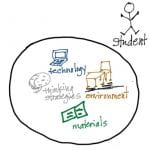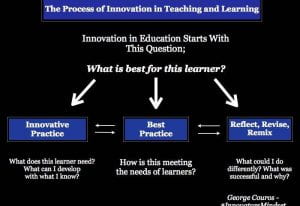Education has been designated to make our youth college-ready; future-ready while conquering learning gaps, equity gaps, social-emotional gaps…However, many educational systems are set up so the student revolves around the “magic bullet” that consists of the best curriculum, the learning environment, and  learning strategies. In other words, if a student is not able to “on-ramp” the designated pathway created, they simply miss the opportunity to grow. “Wait, wuh?! Are we okay with this?” Only selective learners can have access to developed thinking, continuing to support our American ways of democracy and future innovation?
learning strategies. In other words, if a student is not able to “on-ramp” the designated pathway created, they simply miss the opportunity to grow. “Wait, wuh?! Are we okay with this?” Only selective learners can have access to developed thinking, continuing to support our American ways of democracy and future innovation?
Yes, Teachers are inundated with mandates, initiatives, best practices and student variability each year. So how is it possible for a teacher to plan, implement while reaching all students learning strengths and weaknesses and be experts in district movements? It’s not possible! One teacher cannot possibly meet the demands of all criteria within the educational system. No magic bullet exists, even for the teachers we view as exemplary educators. The whole system has to collectively take ownership toward learning. The Universal Design for Learning Framework can guide and support such a mindset. Learning is co-created and owned by the administration, teachers, and students. Administration and teachers develop opportunity and space for professional learning and self-reflection throughout the year. Learning walks, open doors, multiple pathways that can be accessed through the UDL Progression Rubric, ensure better practices override best practices or the myth of being “teacher perfect.” As educational leaders Katie Martin and George Couros advocate,

pedagogy is always evolving and requires innovative tweaks, breaks and bends- due to the new makeup of students each school year. Katie Novak, UDL consultant and Assistant Superintendent, is known to share the connection of a professional runner with an educator. A runner never accomplishes being an expert in their field of work. They are always fine-tuning and refining strategies and techniques to be better. Being an expert is not something that has an endpoint or is accomplished. It is continuously developed, along with people by your side. Same goes with teachers. Working in silos does not create such possibilities. Teachers have to share and as explained through research done by Robert Marzano, teachers have to collectively work together to inspire and build a culture that “anyone can grow!”
Teachers and students have to co-create learning opportunities as well. No way is this to reside solely on the teacher! Teachers design learning through the guidance of the three brain networks. How can students engage in their own

learning? How can learning be made accessible so students can extract information? How can students demonstrate their knowledge through their strengths and while conquering their own barriers? With the guidelines, learning is now designed with the learner in the center.  Learner-centered/ student-centered shifts how learning is done. It is no longer a linear process of lesson planning and assessing the product. Through the UDL lens it is about the teacher designing so students can develop their expertise in learning; how to personally navigate to learn new concepts, ideas or develop expertise toward a passion. Learners ask: What do I need to achieve a goal? Where am I within the goal? How am I going to achieve the goal? As you can see, the learner is becoming knowledgeable about their own learning process- developing into a metacognitive thinker. As we all know, this is the hard part! Being the master of content is not relevant in a world that is heading toward the unknown. Knowing how to learn will create young people with equity and possibilities to interact with the future and the democratic process of our nation.
Learner-centered/ student-centered shifts how learning is done. It is no longer a linear process of lesson planning and assessing the product. Through the UDL lens it is about the teacher designing so students can develop their expertise in learning; how to personally navigate to learn new concepts, ideas or develop expertise toward a passion. Learners ask: What do I need to achieve a goal? Where am I within the goal? How am I going to achieve the goal? As you can see, the learner is becoming knowledgeable about their own learning process- developing into a metacognitive thinker. As we all know, this is the hard part! Being the master of content is not relevant in a world that is heading toward the unknown. Knowing how to learn will create young people with equity and possibilities to interact with the future and the democratic process of our nation.
Let’s start the school year by asking, “What am I doing for students that they could be doing for themselves?” (quoted by educational leader John Spencer). Let’s intentionally design so students have the space to be better! Join the journey to being a designer of possibilities; a designer which creates young adults to be future-ready…ready for anything!
